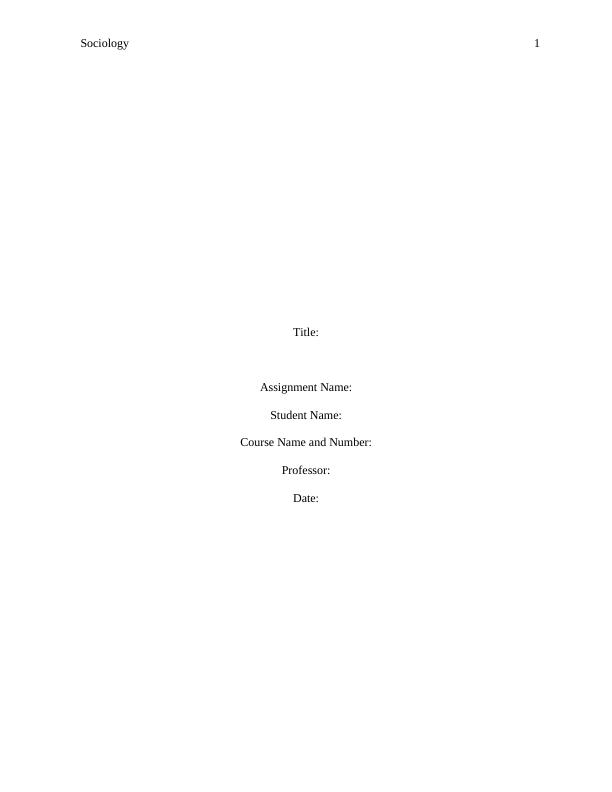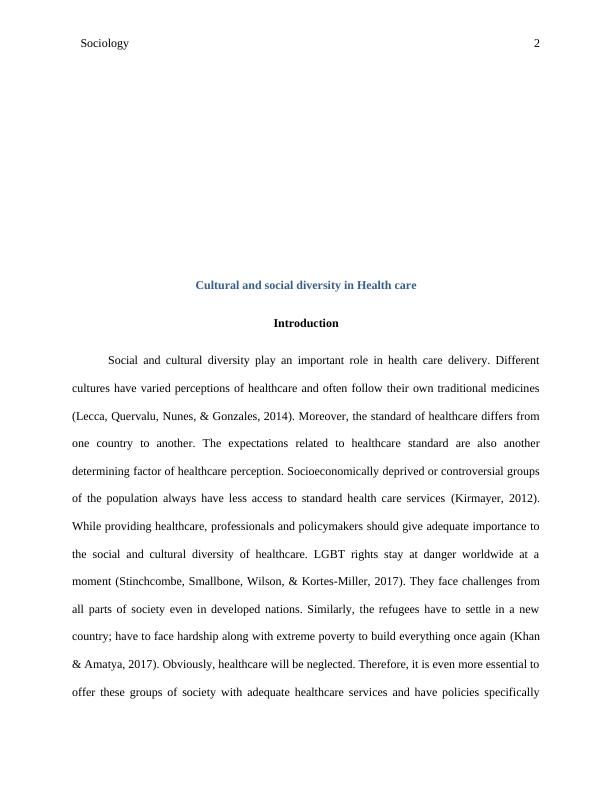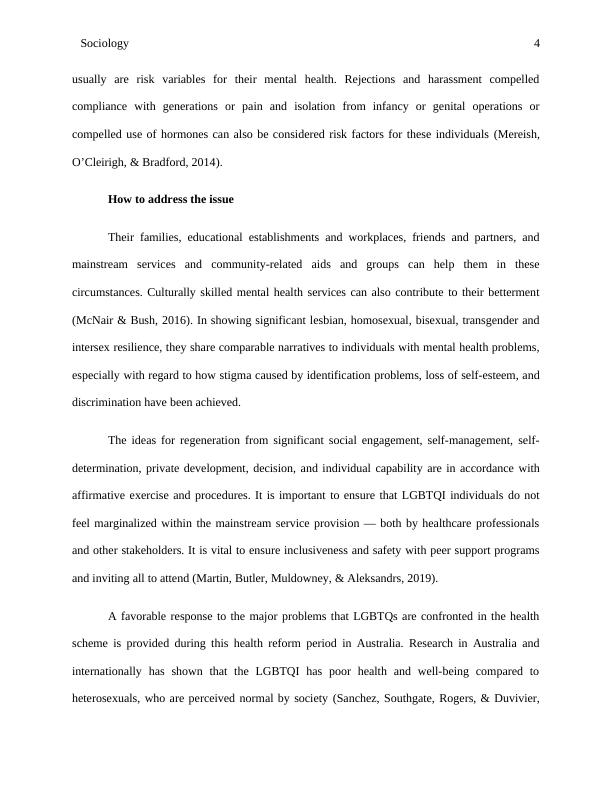Cultural and Social Diversity in Healthcare: A Comparison of Healthcare Accessibility for LGBTQI and Refugees in Australia
Added on 2022-10-19
12 Pages3325 Words299 Views
Sociology 1
Title:
Assignment Name:
Student Name:
Course Name and Number:
Professor:
Date:
Title:
Assignment Name:
Student Name:
Course Name and Number:
Professor:
Date:

Sociology 2
Cultural and social diversity in Health care
Introduction
Social and cultural diversity play an important role in health care delivery. Different
cultures have varied perceptions of healthcare and often follow their own traditional medicines
(Lecca, Quervalu, Nunes, & Gonzales, 2014). Moreover, the standard of healthcare differs from
one country to another. The expectations related to healthcare standard are also another
determining factor of healthcare perception. Socioeconomically deprived or controversial groups
of the population always have less access to standard health care services (Kirmayer, 2012).
While providing healthcare, professionals and policymakers should give adequate importance to
the social and cultural diversity of healthcare. LGBT rights stay at danger worldwide at a
moment (Stinchcombe, Smallbone, Wilson, & Kortes-Miller, 2017). They face challenges from
all parts of society even in developed nations. Similarly, the refugees have to settle in a new
country; have to face hardship along with extreme poverty to build everything once again (Khan
& Amatya, 2017). Obviously, healthcare will be neglected. Therefore, it is even more essential to
offer these groups of society with adequate healthcare services and have policies specifically
Cultural and social diversity in Health care
Introduction
Social and cultural diversity play an important role in health care delivery. Different
cultures have varied perceptions of healthcare and often follow their own traditional medicines
(Lecca, Quervalu, Nunes, & Gonzales, 2014). Moreover, the standard of healthcare differs from
one country to another. The expectations related to healthcare standard are also another
determining factor of healthcare perception. Socioeconomically deprived or controversial groups
of the population always have less access to standard health care services (Kirmayer, 2012).
While providing healthcare, professionals and policymakers should give adequate importance to
the social and cultural diversity of healthcare. LGBT rights stay at danger worldwide at a
moment (Stinchcombe, Smallbone, Wilson, & Kortes-Miller, 2017). They face challenges from
all parts of society even in developed nations. Similarly, the refugees have to settle in a new
country; have to face hardship along with extreme poverty to build everything once again (Khan
& Amatya, 2017). Obviously, healthcare will be neglected. Therefore, it is even more essential to
offer these groups of society with adequate healthcare services and have policies specifically

Sociology 3
driven towards these communities (Khan & Amatya, 2017). The current essay focuses on the
comparison between the two socially deprived communities in Australia in relation to healthcare
accessibility. An effort is made to address both the similarities and differences among these two
population groups.
Healthcare provision to LGBTQI in Australia
Respect is central to cultural competence-patients who think that their health care
suppliers respect their cultures, language, principles, traditions, and views are more inclined to
interact openly and sincerely. In a setting for health and social welfare, the core of a social
setting depends on the equality and inclusion of all individuals. As a life-long growth phase,
homosexual identity is abstracted by most societies (Gahagan & Colpitts, 2017). It is important
to provide a social structure where an individual to accept a favorable homosexual self-image
and a definite personal identity.
Health-Related Risk Factors
Research has shown that an overly large proportion of LGBTQI population has a greater
risk than their counterparts for suicidal tendencies. Evidence shows that LGBTI individuals and
community at high danger of suicide is not linked to genders identity, sexuality, or intersex
features, but because of psychological suffering that could happen in connection with their own
LGBTI identity, feelings of discrimination, bias, the experience of abuse, violence, and feeling
of exclusion.
Multi-layered stigma, marginalization, and discrimination are detrimental to many
transgender, lesbian, intersexes, gay, and bisexual individuals. Violence, intimidation or
dismissal and discrimination from workplaces, families, education, community, and colleagues -
driven towards these communities (Khan & Amatya, 2017). The current essay focuses on the
comparison between the two socially deprived communities in Australia in relation to healthcare
accessibility. An effort is made to address both the similarities and differences among these two
population groups.
Healthcare provision to LGBTQI in Australia
Respect is central to cultural competence-patients who think that their health care
suppliers respect their cultures, language, principles, traditions, and views are more inclined to
interact openly and sincerely. In a setting for health and social welfare, the core of a social
setting depends on the equality and inclusion of all individuals. As a life-long growth phase,
homosexual identity is abstracted by most societies (Gahagan & Colpitts, 2017). It is important
to provide a social structure where an individual to accept a favorable homosexual self-image
and a definite personal identity.
Health-Related Risk Factors
Research has shown that an overly large proportion of LGBTQI population has a greater
risk than their counterparts for suicidal tendencies. Evidence shows that LGBTI individuals and
community at high danger of suicide is not linked to genders identity, sexuality, or intersex
features, but because of psychological suffering that could happen in connection with their own
LGBTI identity, feelings of discrimination, bias, the experience of abuse, violence, and feeling
of exclusion.
Multi-layered stigma, marginalization, and discrimination are detrimental to many
transgender, lesbian, intersexes, gay, and bisexual individuals. Violence, intimidation or
dismissal and discrimination from workplaces, families, education, community, and colleagues -

Sociology 4
usually are risk variables for their mental health. Rejections and harassment compelled
compliance with generations or pain and isolation from infancy or genital operations or
compelled use of hormones can also be considered risk factors for these individuals (Mereish,
O’Cleirigh, & Bradford, 2014).
How to address the issue
Their families, educational establishments and workplaces, friends and partners, and
mainstream services and community-related aids and groups can help them in these
circumstances. Culturally skilled mental health services can also contribute to their betterment
(McNair & Bush, 2016). In showing significant lesbian, homosexual, bisexual, transgender and
intersex resilience, they share comparable narratives to individuals with mental health problems,
especially with regard to how stigma caused by identification problems, loss of self-esteem, and
discrimination have been achieved.
The ideas for regeneration from significant social engagement, self-management, self-
determination, private development, decision, and individual capability are in accordance with
affirmative exercise and procedures. It is important to ensure that LGBTQI individuals do not
feel marginalized within the mainstream service provision — both by healthcare professionals
and other stakeholders. It is vital to ensure inclusiveness and safety with peer support programs
and inviting all to attend (Martin, Butler, Muldowney, & Aleksandrs, 2019).
A favorable response to the major problems that LGBTQs are confronted in the health
scheme is provided during this health reform period in Australia. Research in Australia and
internationally has shown that the LGBTQI has poor health and well-being compared to
heterosexuals, who are perceived normal by society (Sanchez, Southgate, Rogers, & Duvivier,
usually are risk variables for their mental health. Rejections and harassment compelled
compliance with generations or pain and isolation from infancy or genital operations or
compelled use of hormones can also be considered risk factors for these individuals (Mereish,
O’Cleirigh, & Bradford, 2014).
How to address the issue
Their families, educational establishments and workplaces, friends and partners, and
mainstream services and community-related aids and groups can help them in these
circumstances. Culturally skilled mental health services can also contribute to their betterment
(McNair & Bush, 2016). In showing significant lesbian, homosexual, bisexual, transgender and
intersex resilience, they share comparable narratives to individuals with mental health problems,
especially with regard to how stigma caused by identification problems, loss of self-esteem, and
discrimination have been achieved.
The ideas for regeneration from significant social engagement, self-management, self-
determination, private development, decision, and individual capability are in accordance with
affirmative exercise and procedures. It is important to ensure that LGBTQI individuals do not
feel marginalized within the mainstream service provision — both by healthcare professionals
and other stakeholders. It is vital to ensure inclusiveness and safety with peer support programs
and inviting all to attend (Martin, Butler, Muldowney, & Aleksandrs, 2019).
A favorable response to the major problems that LGBTQs are confronted in the health
scheme is provided during this health reform period in Australia. Research in Australia and
internationally has shown that the LGBTQI has poor health and well-being compared to
heterosexuals, who are perceived normal by society (Sanchez, Southgate, Rogers, & Duvivier,

End of preview
Want to access all the pages? Upload your documents or become a member.
Related Documents
Working with Diverse and Aboriginal Australianslg...
|10
|1908
|482
LGBTQ+ with depression, culture and social justice in Australialg...
|8
|1911
|199
Heterosexism and its Impact on the LGBTIQ Communitylg...
|4
|767
|326
Suicide Prevention and Mental Healthlg...
|6
|1717
|99
B6005 - Reproductive and Sexual Healthcarelg...
|4
|851
|46
Cultural and Social Diversity in Healthcarelg...
|12
|3547
|421
